
The Echinothurioida are an order of sea urchins in the class Echinoidea. Echinothurioids are distinguished from other sea urchins by the combination of a flexible test and hollow spines. The membrane around the mouth contains only simple plates, in contrast to the more complex mouth parts of their close relatives, the Diadematoida. They are nearly all deepsea dwellers.

The Camarodonta are an order of globular sea urchins in the class Echinoidea. The fossil record shows that camarodonts have been in existence since the Lower Cretaceous.
Araeosoma alternatum is a species of sea urchin of the family Echinothuriidae. Its armour is covered with spines. It is placed in the genus Araeosoma and lives in the sea. A. alternatum was first scientifically described in 1934 by Ole Theodor Jensen Mortensen, a Danish zoologist.
Araeosoma belli is a species of sea urchin of the family Echinothuriidae. Its armour is covered with spines. It is placed in the genus Araeosoma and lives throughout the Caribbean Sea as well as areas around the Gulf of Mexico. A. belli was first scientifically described in 1903 by Ole Theodor Jensen Mortensen, a Danish zoologist.
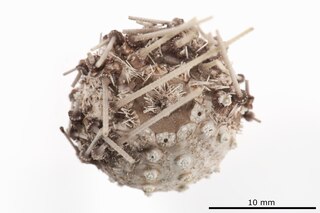
Aspidodiadema africanum is a species of sea urchin of the family Aspidodiadematidae. Their armour is covered with spines. It is placed in the genus Aspidodiadema and lives in the sea. Aspidodiadema africanum was first scientifically described in 1939 by Ole Theodor Jensen Mortensen, a Danish scientist.

Aspidodiadema arcitum is a species of sea urchin of the family Aspidodiadematidae. Their armour is covered with spines. It is placed in the genus Aspidodiadema and lives in the sea. Aspidodiadema arcitum was first scientifically described in 1939 by Ole Theodor Jensen Mortensen, a Danish scientist.

Aspidodiadema hawaiiense is a species of sea urchin of the family Aspidodiadematidae. Their armor is covered with spines. It is placed in the genus Aspidodiadema and lives in the sea. Aspidodiadema hawaiiense was first scientifically described in 1939 by Ole Theodor Jensen Mortensen, a Danish scientist.
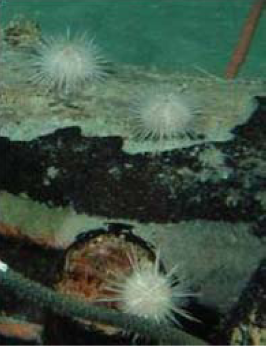
Asterechinus elegans is a species of sea urchin of the family Trigonocidaridae. Their armour is covered with spines. It is the only species in the genus Asterechinus and lives in the sea. Asterechinus elegans was first scientifically described in 1942 by Ole Theodor Jensen Mortensen.
Breynia elegans is a species of sea urchins of the family Loveniidae. Their armour is covered with spines. Breynia elegans was first scientifically described in 1948 by Ole Theodor Jensen Mortensen.
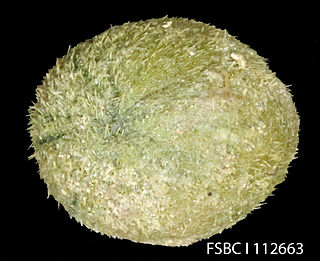
Brissopsis alta is a species of sea urchins of the family Brissidae. Their armour is covered with spines. Brissopsis alta was first scientifically described in 1907 by Ole Mortensen.
Brissopsis similis is a species of sea urchins of the family Brissidae. Their armour is covered with spines. Brissopsis similis was first scientifically described in 1948 by Ole Theodor Jensen Mortensen.
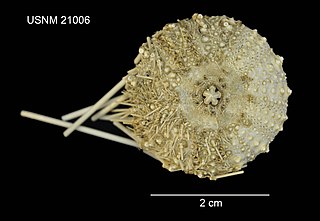
Caenopedina diomedeae is a species of sea urchins of the Family Pedinidae. Their armour is covered with spines. Caenopedina diomedeae was first scientifically described in 1939 by Ole Theodor Jensen Mortensen.
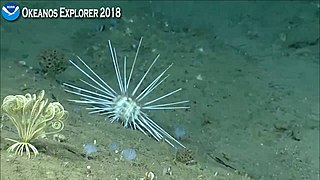
Calocidaris micans is a species of sea urchins of the family Cidaridae. Their armour is covered with spines. Calocidaris micans was first scientifically described in 1903 by Ole Mortensen.
Chaetodiadema africanum is a species of sea urchins of the Family Diadematidae. Their armour is covered with spines. Chaetodiadema africanum was first scientifically described in 1924 by Hubert Lyman Clark.

Chaetodiadema granulatum is a species of sea urchins of the Family Diadematidae. Their armour is covered with long and slender spines, and the test is quite flattened.
Chaetodiadema japonicum is a species of sea urchins of the Family Diadematidae. Their armor is covered with spines. Chaetodiadema japonicum was first scientifically described in 1904 by Ole Theodor Jensen Mortensen.
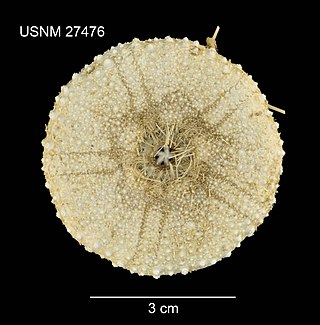
Chaetodiadema pallidum is a species of sea urchins of the Family Diadematidae. Their armour is covered with spines. Chaetodiadema pallidum was first scientifically described in 1907 by Alexander Emanuel Agassiz and Hubert Lyman Clark.
Chaetodiadema tuberculatum is a species of sea urchins of the Family Diadematidae. Their armour is covered with spines. Chaetodiadema tuberculatum was first scientifically described in 1909 by Hubert Lyman Clark.
Cidaris mabahissae is a species of sea urchins of the Family Cidaridae. Their armour is covered with spines. Cidaris mabahissae was first scientifically described in 1939 by Ole Mortensen.

Chaetodiadema is a genus of sea urchins of the Family Diadematidae. Their armour is covered with spines.











